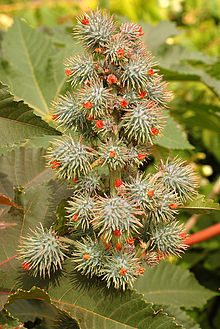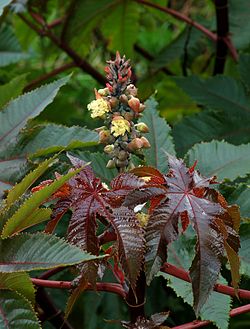|

Ricinus communis
Ricin is one of the most poisonous naturally occuring substances known.
The castor oil plant, Ricinus communis, is a species of flowering plant in the spurge family, Euphorbiaceae. It belongs to a monotypic genus, Ricinus, and subtribe, Ricininae. The evolution of castor and its relation to other species are currently being studied using modern genetic tools. Its seed is the castor bean which, despite its name, is not a true bean. Castor is indigenous to the southeastern Mediterranean Basin, Eastern Africa, and India, but is widespread throughout tropical regions (and widely grown elsewhere as an ornamental plant). Castor seed is the source of castor oil, which has a wide variety of uses. The seeds contain between 40% and 60% oil that is rich in triglycerides, mainly ricinolein. The seed contains ricin, a toxin, which is also present in lower concentrations throughout the plant.
An unrelated plant species, Fatsia japonica, is similar in appearance and known as the false castor oil plant.
Description

Female (top) and male flowers
The castor oil plant can vary greatly in its growth habit and appearance. The variability has been increased by breeders who have selected a range of cultivars for leaf and flower colours, and for oil production. It is a fast-growing, suckering perennial shrub which can reach the size of a small tree (around 12 metres/39 feet), but it is not cold hardy.
The glossy leaves are 15-45 centimetres (5.9-18 in) long, long-stalked, alternate and palmate with 5-12 deep lobes with coarsely toothed segments. In some varieties they start off dark reddish purple or bronze when young, gradually changing to a dark green, sometimes with a reddish tinge, as they mature. The leaves of some other varieties are green practically from the start, whereas in yet others a pigment masks the green colour of all the chlorophyll-bearing parts, leaves, stems and young fruit, so that they remain a dramatic purple-to-reddish-brown throughout the life of the plant. Plants with the dark leaves can be found growing next to those with green leaves, so there probably is only a single gene controlling the production of the pigment in some varieties at least. The stems (and the spherical, spiny seed capsules) also vary in pigmentation. The fruit capsules of some varieties are more showy than the flowers.

Seeds
The flowers are borne in terminal panicle-like inflorescences of green or, in some varieties, shades of red monoecious flowers without petals. The male flowers are yellowish-green with prominent creamy stamens and are carried in ovoid spikes up to 15 centimetres (5.9 in) long; the female flowers, born at the tips of the spikes, have prominent red stigmas. The fruit is a spiny, greenish (to reddish-purple) capsule containing large, oval, shiny, bean-like, highly poisonous seeds with variable brownish mottling. Castor seeds have a warty appendage called the caruncle, which is a type of elaiosome. The caruncle promotes the dispersal of the seed by ants (myrmecochory).
Nomenclature
The name Ricinus is a Latin word for tick; the seed is so named because it has markings and a bump at the end which resemble certain ticks. The common name "castor oil" probably comes from its use as a replacement for castoreum, a perfume base made from the dried perineal glands of the beaver (castor in Latin). It has another common name, palm of Christ, or Palma Christi, that derives from castor oil's reputed ability to heal wounds and cure ailments.
Toxicity
The toxicity of raw castor beans due to the presence of ricin is well-known. Although the lethal dose in adults is considered to be four to eight seeds, reports of actual poisoning are relatively rare. According to the 2007 edition of the Guinness Book of World Records, this plant is the most poisonous in the world. Despite this, suicides involving ingestion of castor beans are unheard of in countries like India where castor grows abundantly on the roadsides, which may be attributed to the rather painful and unpleasant symptoms of overdosing on ricin, which can include nausea, diarrhea, tachycardia, hypotension and seizures persisting for up to a week. However, it is well known that the poison can be extracted from castor by concentrating it with a fairly complicated process similar to that used for extracting cyanide from almonds.
If ingested, symptoms may be delayed by up to 36 hours but commonly begin within 2-4 hours. These include a burning sensation in mouth and throat, abdominal pain, purging and bloody diarrhoea. Within several days there is severe dehydration, a drop in blood pressure and a decrease in urine. Unless treated, death can be expected to occur within 3-5 days, however in most cases a full recovery can be made.
Poisoning occurs when animals, including humans, ingest broken seeds or break the seed by chewing: intact seeds may pass through the digestive tract without releasing the toxin. Toxicity varies among animal species: four seeds will kill a rabbit, five a sheep, six an ox or horse, seven a pig, and eleven a dog. Ducks have shown incredible resistance to the seeds: it takes an average of 80 to kill them. The toxin provides the castor oil plant with some degree of natural protection from insect pests such as aphids. In fact, ricin has been investigated for its potential use as an insecticide. The castor oil plant is also the source for undecylenic acid, a natural fungicide. ..."
Symptoms for a poisoning
In most of the cases you can notice the symptoms several hours after the consumption. There is no antidote. The toxic ricin attacks the whole cardiovascular system until the heart finally stops to beat. Possible symptoms are:
- Drooling
- Enteritis (inflammation of the stomach and intestine)
- Fever
- Irritations of the mucous membrane
- Spasm
- Blood screening shows a reduction of the red blood cells"
Other symptoms may include:
- Severe dehydration
- Decreased urine
- Colic
- Diarrhea, often bloody
Decrease in blood pressure
Note: "Castor beans are used as an ingredient in some animal feeds after the oil has been extracted or inactivated by heating for 20 minutes at 140ºC. Attempts to use castor beans in feed for livestock involve different methods of inactivating ricin while maintaining nutritional value. Some studies have shown that even after such heat treatment, toxicity remains. For example, it was lethal to mallard ducks given the feed. 'The toxicity of the meal could be due to either a heat stable or growth inhibiting factor or due to minute residues of ricin'(Okoye et al.) A study with sheep showed that autoclaved castor-bean-meal can be incorporated to 10% of sheep rations without any ill effect. Poisoning of livestock usually occurs by accidental incorporation of castor beans in their feed. Horses are particularly vulnerable." Ricin Toxin from Castor Bean Plant, Ricinus communis
Call your vet immediately!
|